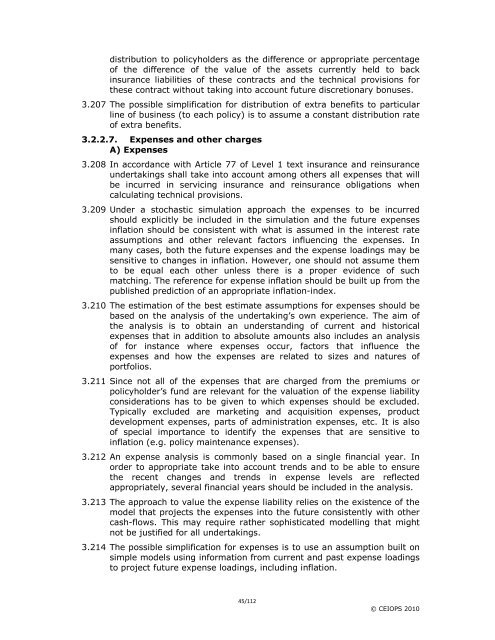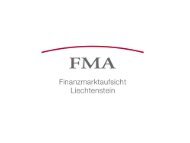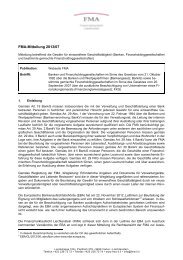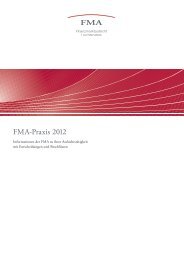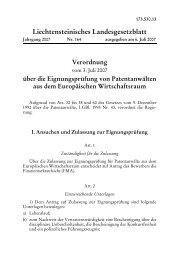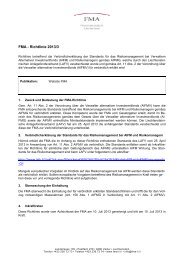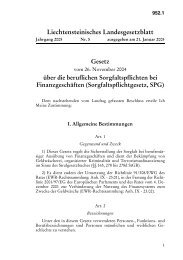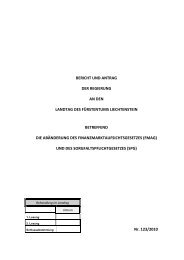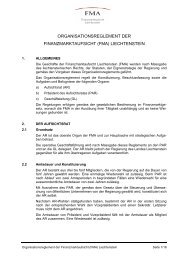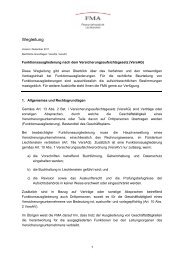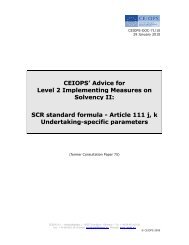CEIOPS' Advice for Level 2 Implementing ... - EIOPA - Europa
CEIOPS' Advice for Level 2 Implementing ... - EIOPA - Europa
CEIOPS' Advice for Level 2 Implementing ... - EIOPA - Europa
You also want an ePaper? Increase the reach of your titles
YUMPU automatically turns print PDFs into web optimized ePapers that Google loves.
distribution to policyholders as the difference or appropriate percentage<br />
of the difference of the value of the assets currently held to back<br />
insurance liabilities of these contracts and the technical provisions <strong>for</strong><br />
these contract without taking into account future discretionary bonuses.<br />
3.207 The possible simplification <strong>for</strong> distribution of extra benefits to particular<br />
line of business (to each policy) is to assume a constant distribution rate<br />
of extra benefits.<br />
3.2.2.7. Expenses and other charges<br />
A) Expenses<br />
3.208 In accordance with Article 77 of <strong>Level</strong> 1 text insurance and reinsurance<br />
undertakings shall take into account among others all expenses that will<br />
be incurred in servicing insurance and reinsurance obligations when<br />
calculating technical provisions.<br />
3.209 Under a stochastic simulation approach the expenses to be incurred<br />
should explicitly be included in the simulation and the future expenses<br />
inflation should be consistent with what is assumed in the interest rate<br />
assumptions and other relevant factors influencing the expenses. In<br />
many cases, both the future expenses and the expense loadings may be<br />
sensitive to changes in inflation. However, one should not assume them<br />
to be equal each other unless there is a proper evidence of such<br />
matching. The reference <strong>for</strong> expense inflation should be built up from the<br />
published prediction of an appropriate inflation-index.<br />
3.210 The estimation of the best estimate assumptions <strong>for</strong> expenses should be<br />
based on the analysis of the undertaking’s own experience. The aim of<br />
the analysis is to obtain an understanding of current and historical<br />
expenses that in addition to absolute amounts also includes an analysis<br />
of <strong>for</strong> instance where expenses occur, factors that influence the<br />
expenses and how the expenses are related to sizes and natures of<br />
portfolios.<br />
3.211 Since not all of the expenses that are charged from the premiums or<br />
policyholder’s fund are relevant <strong>for</strong> the valuation of the expense liability<br />
considerations has to be given to which expenses should be excluded.<br />
Typically excluded are marketing and acquisition expenses, product<br />
development expenses, parts of administration expenses, etc. It is also<br />
of special importance to identify the expenses that are sensitive to<br />
inflation (e.g. policy maintenance expenses).<br />
3.212 An expense analysis is commonly based on a single financial year. In<br />
order to appropriate take into account trends and to be able to ensure<br />
the recent changes and trends in expense levels are reflected<br />
appropriately, several financial years should be included in the analysis.<br />
3.213 The approach to value the expense liability relies on the existence of the<br />
model that projects the expenses into the future consistently with other<br />
cash-flows. This may require rather sophisticated modelling that might<br />
not be justified <strong>for</strong> all undertakings.<br />
3.214 The possible simplification <strong>for</strong> expenses is to use an assumption built on<br />
simple models using in<strong>for</strong>mation from current and past expense loadings<br />
to project future expense loadings, including inflation.<br />
45/112<br />
© CEIOPS 2010


